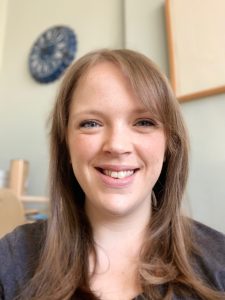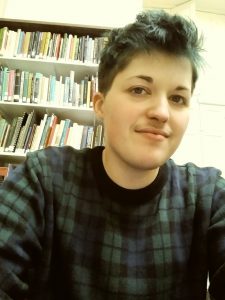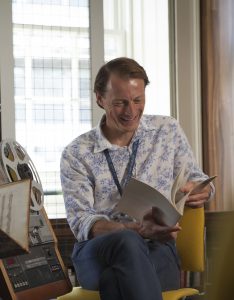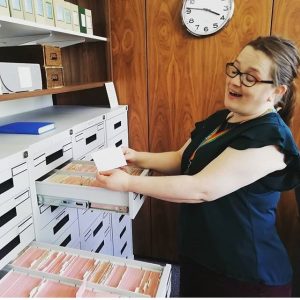For our second blog and part two to the last blog Queering the Archive, join us as we celebrate the cultural records of ‘drag’ in the archives.
Drag is described as a gender performance artform for entertainment. The term itself developed in British theatre circles in the 19th century but drag has been around as a theatrical and performance artform since ancient history. Drag as performance in Britain is often cited back to being historically popularised in theatre and the plays of Shakespeare and his contemporaries. As was the same with performance in ancient Greek plays, male players could take the stage and thus would have to dress as women for their performance. While drag on stage was acceptable, off the stage is another story entirely. Cross-dressing was illegal and clothing was strictly regulated to gender, and arrests were made if individuals were not viewed as wearing enough articles of clothing within their perceived gender. Generally, theatric circles were one of the only places where drag was accepted in the general public sphere. LGBT+ identities were kept underground due to criminalisation and societal attitudes. Drag was kept in the sphere of performance, literature, bawdy tales, ballads and broadsheets with a few popular and break-out drag and impersonation performers. Drag itself has thrived in queer circles throughout history and has been an important aspect of queer art, performance, and transgression and identity. The first person to self identify as the ‘queen of drag’ was William Dorsey Swann. In the UK, the first drag queen is credited as Princess Seraphina and was a staple of “Molly Houses.” In British stage circles, male impersonation was popular in the Music Hall scene and elsewhere with performers such as Vesta Tilley.
Within the School of Scottish Studies Archives, we have examples of ballads, songs, and cultural tradition that describes drag as performance and entertainment. While the records I have selected are not evidence of queer transgression and identity that comes with drag and gender performance, it is evidence of what exists in the Scottish public sphere of tales and cultural life alongside the previous blog of the ‘Cross-Dressing’ ballads. These oral history accounts describe cultural aspects and accepted fluidity of performance and tradition. A kind of ‘drag’ performance was relatively popular in some Scottish cultural traditions. Through Christmas and New Year’s guising and galoshins customs, both children and adults would often dress in a form of drag for fun and fancy-dress. Guising involved groups of people going from door to door or taking part in singing, playing music, dancing and festivities. Hugh Jamieson, recorded in Gott, Shetland, describes some of the outfits when recorded by Alan J. Bruford. ‘The guisers dressed in home-made outfits with false faces [masks] bought from the shop. The men dressed as women and the women as men. They would dress in wigs and wide skirts, with whiskers made from sheepskins.’ (SA1974.216) Jamieson fondly recalls this custom when asked of dressing up and guising and the fun that was had.
Wat Ramage, recorded at Westruther, describes the songs that were sung and traditions of guising, and how as children: ‘the laddies were made to dress up in women’s clothes, and the lassies would dress in the boy’s clothes.’ (SA1977.205)
Drag and dressing up as characters and creatures was also common in galoshin’s plays themselves and drag in Scottish cultural tradition and customs can be viewed as a form of shared fun and taking part in festivities and theatrics. Of course, drag was not the term that would be used, but the theatrics of dressing up is remembered fondly and put quite simply by Jamieson and Ramage. Drag is also something that exists in many other culture’s traditions and plays outside of Scotland and can be an example of how drag has been shaped by cultural tradition and forms of theatrics and has always existed in different forms in the accepted public sphere throughout history.
Of course, this is just a brief example on the history of drag and performance as well as Scottish cultural traditions and is not a complete history. Drag goes beyond the binary and remains a transgressive artform that is a key part of queer history and the history of performance and tradition. This blog is an attempt to illustrate how our records can show fluidity and societal attitudes in Scottish cultural tradition and theatric spaces.
The records selected from our collection can be accessed via Tobar an Dualchais. This includes but is not limited to:
Hugh Jameson, ‘Guising at Old Christmas and New Year’. Recorded by Alan J. Bruford. (SA1974.216) http://tobarandualchais.co.uk/en/fullrecord/48475
Donald John MacDonald, ‘Duan na Callaig’. Recorded by John MacInnes. (SA1966.064) http://tobarandualchais.co.uk/en/fullrecord/57790
Wat Ramage, ‘Galoshins’. Recorded by Dr. Emily Lyle. (SA1977.205) http://tobarandualchais.co.uk/en/fullrecord/42571
This blog is part of the ‘Queering the Archive’ initiative, which involves intervention workshops as well as blogs of application of queer theory. See past blogs for further details of ‘Queering the Archives’. If you are interested in taking part in the workshops, or if you are interested in researching LGBT+ records, using our collections for your work, or working with us, please contact eholmes@ed.ac.uk
Written by Elliot Holmes.
Elliot is one of the Archives and Library Assistants at the School of Scottish Studies Archives and uses He/They pronouns. You can also find him on twitter @elliotlholmes
Follow @EU_SSSA on twitter for updates and sharing our collections.








